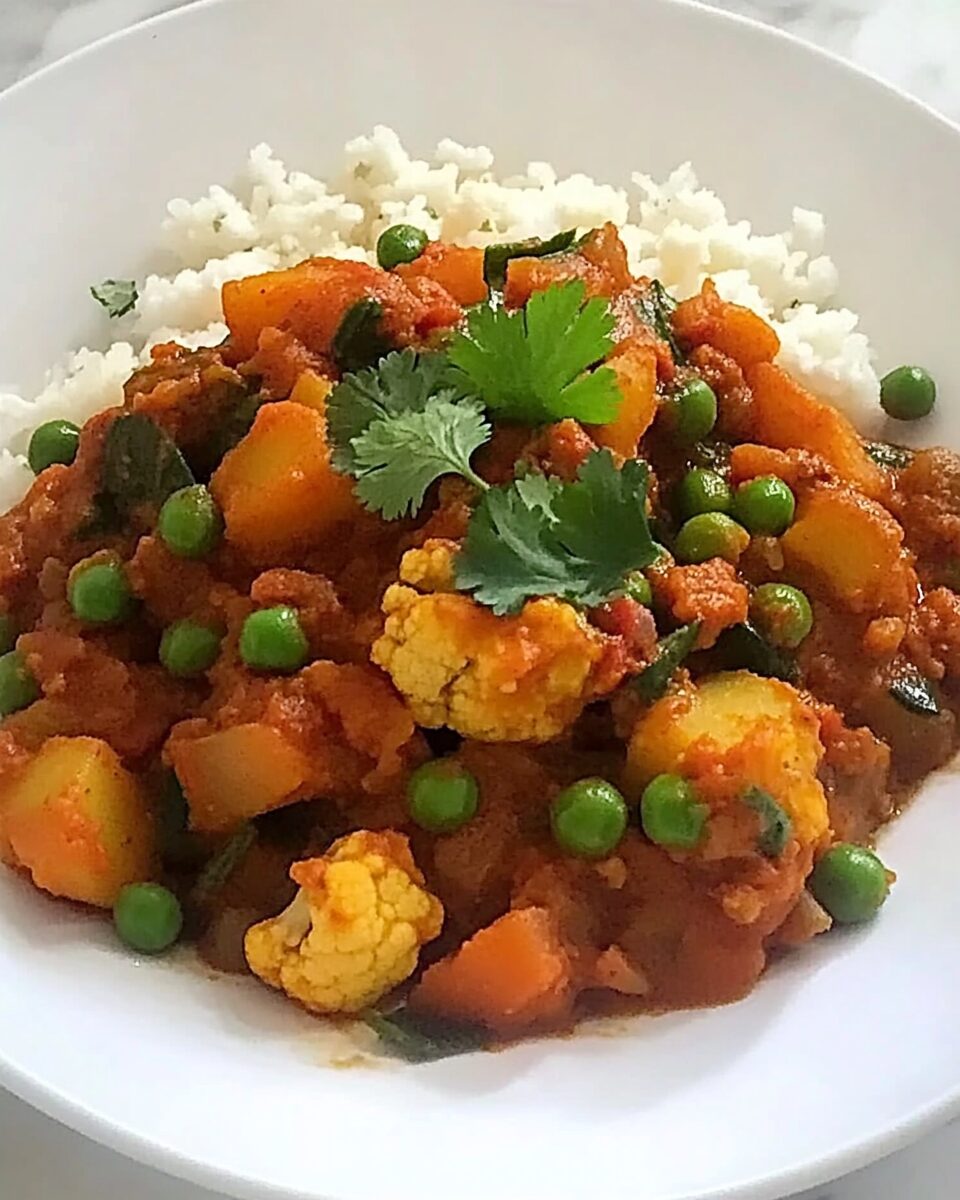The Mixed Vegetable Masala is a heartwarming, spiced vegetable curry that’s not only full of flavor but also packed with nutrition. Featuring a blend of cauliflower, potatoes, green beans, peas, and carrots, it’s simmered in a rich tomato-onion masala seasoned with fragrant Indian spices. Perfect for serving with basmati rice or warm naan, this dish brings the taste of traditional Indian comfort food to your table. It’s naturally gluten-free and vegan, making it a versatile option for many dietary preferences. Whether you’re meal-prepping for the week or cooking a cozy dinner for the family, this masala is a nourishing and flavorful winner.
Full Recipe:
Ingredients:
-
2 tablespoons coconut oil
-
1 teaspoon cumin seeds
-
1 onion, finely chopped
-
1 tablespoon ginger, minced
-
4 cloves garlic, minced
-
2 tomatoes, finely chopped
-
1 teaspoon ground turmeric
-
1 teaspoon ground coriander
-
1 teaspoon garam masala
-
1/2 teaspoon chili powder (adjust to taste)
-
1 teaspoon salt, or to taste
-
1/2 cup carrots, chopped
-
1/2 cup green beans, chopped
-
1/2 cup green peas
-
1/2 cup cauliflower florets
-
1/2 cup potatoes, peeled and cubed
-
1/4 cup water
-
Fresh cilantro for garnish
Directions:
-
Heat coconut oil in a large skillet or pan over medium heat.
-
Add cumin seeds and let them sizzle for a few seconds until fragrant.
-
Stir in chopped onions and sauté until golden and soft.
-
Add minced ginger and garlic, cooking for 1-2 minutes until aromatic.
-
Add chopped tomatoes and cook down until soft and oil begins to separate.
-
Stir in turmeric, coriander, garam masala, chili powder, and salt. Mix well.
-
Add all the vegetables: carrots, green beans, peas, cauliflower, and potatoes.
-
Pour in water, stir to coat everything in spices, and cover.
-
Simmer on low heat for 20-25 minutes or until vegetables are tender.
-
Uncover and let any excess moisture evaporate if needed, stirring gently.
-
Garnish with fresh cilantro before serving.
Prep Time: 15 minutes | Cooking Time: 25 minutes | Total Time: 40 minutes
Kcal: 180 kcal | Servings: 4 servings
Mixed Vegetable Masala: A Flavorful and Nutritious Indian Classic
Mixed Vegetable Masala is a beloved staple in Indian cuisine, cherished for its vibrant flavors, aromatic spices, and wholesome ingredients. This dish combines a variety of fresh vegetables simmered in a rich and fragrant masala gravy, making it a perfect example of how simple ingredients can be transformed into a nourishing, comforting meal. Whether you’re a seasoned cook or a curious food lover, this dish offers both taste and versatility, making it a favorite across households and dining tables worldwide.
The Origins and Cultural Significance
Mixed Vegetable Masala, often called “sabzi” or “vegetable curry” in India, is a quintessential part of Indian home cooking. It reflects the culinary philosophy of Indian cuisine balancing spices, textures, and seasonal produce to create complex yet harmonious flavors. Rooted deeply in vegetarian traditions, especially in regions like Punjab and Gujarat, this dish caters to a wide range of dietary needs and preferences, from vegan to gluten-free diets.
The use of masala a blend of ground spices including cumin, coriander, turmeric, and garam masala adds layers of warmth and depth, elevating everyday vegetables into a feast for the senses. Beyond its taste, the dish carries cultural importance as a symbol of hospitality and nourishment, often prepared for family gatherings, festivals, and special occasions.
Nutritional Benefits of Mixed Vegetable Masala
One of the biggest appeals of Mixed Vegetable Masala is its nutritional richness. The variety of vegetables used such as carrots, cauliflower, potatoes, green beans, and peas provides a broad spectrum of vitamins, minerals, fiber, and antioxidants.
-
Rich in Fiber: Vegetables like green beans and peas contribute to digestive health by providing dietary fiber, which supports gut function and promotes satiety.
-
Packed with Vitamins and Minerals: Carrots add beta-carotene (vitamin A), cauliflower offers vitamin C and folate, while potatoes supply potassium and vitamin B6.
-
Low in Calories and Fat: When prepared with healthy oils such as coconut or mustard oil, this dish remains low in saturated fat, making it heart-healthy.
-
Plant-Based Protein: Peas and potatoes contribute modest amounts of plant protein, enhancing the dish’s overall nutritional value.
Because it’s naturally vegan and gluten-free, Mixed Vegetable Masala fits well within many modern dietary lifestyles, including plant-based and allergy-sensitive eating plans.
The Role of Spices in the Dish
What truly distinguishes Mixed Vegetable Masala from a simple vegetable stew is its aromatic spice profile. Indian cuisine is famous for its use of spices that not only enhance flavor but also provide health benefits.
-
Turmeric: Known for its anti-inflammatory properties and vibrant yellow color.
-
Cumin: Adds an earthy, slightly nutty flavor and aids digestion.
-
Coriander: Offers a citrusy undertone that balances richer spices.
-
Garam Masala: A warm blend of spices like cinnamon, cloves, and cardamom that adds complexity.
-
Chili Powder: Provides heat and excitement, which can be adjusted to taste.
The technique of tempering whole cumin seeds in hot oil at the start releases essential oils, creating a fragrant base that infuses every bite with flavor. The slow simmering process melds these spices with the vegetables, ensuring a well-rounded, deeply satisfying dish.
Versatility and Serving Suggestions
Mixed Vegetable Masala’s flexibility is one of its greatest strengths. It can be adapted to whatever vegetables you have on hand or prefer bell peppers, zucchini, spinach, or eggplant all make excellent additions. The spice level is fully customizable to suit mild or fiery palates.
Traditionally, this masala is served alongside fluffy basmati rice or warm Indian breads such as roti, naan, or paratha. It also pairs well with lentils (dal) or yogurt-based sides like raita to balance the spices and add a creamy contrast.
For a more substantial meal, consider serving it with a side of dal or chickpea curry. Leftovers also reheat beautifully, making it an ideal dish for meal prepping and busy weeknight dinners.
Health Benefits and Suitability for Special Diets
Because Mixed Vegetable Masala uses whole, plant-based ingredients without any dairy or gluten-containing products, it suits a wide range of special diets:
-
Vegan and Vegetarian: No animal products are used, making it fully plant-based.
-
Gluten-Free: No wheat or gluten ingredients, safe for those with celiac disease or gluten intolerance.
-
Dairy-Free: Ideal for lactose-intolerant individuals or those avoiding dairy.
-
Low Glycemic: The inclusion of various vegetables with fiber helps regulate blood sugar levels.
-
Anti-Inflammatory: Thanks to turmeric and other spices, the dish offers anti-inflammatory benefits.
This makes Mixed Vegetable Masala an excellent choice for anyone seeking a healthy, balanced, and flavorful meal without compromising on taste.
Tips for Perfecting Your Mixed Vegetable Masala
-
Use fresh, seasonal vegetables: This enhances both taste and nutrition.
-
Balance spices: Adjust chili and garam masala quantities to your liking.
-
Don’t rush the cooking: Let the vegetables simmer slowly to absorb flavors.
-
Add a squeeze of lemon or a sprinkle of fresh cilantro: This brightens the dish before serving.
-
Experiment with oils: Coconut oil adds a traditional South Indian flavor, while mustard oil lends a pungent note favored in Eastern India.
Conclusion:
Mixed Vegetable Masala is more than just a dish it’s a celebration of Indian culinary traditions that embraces health, flavor, and simplicity. By combining colorful vegetables with a harmonious blend of spices, it offers a nutritious, comforting meal suitable for a wide range of diets and occasions.
Its adaptability and ease of preparation make it a fantastic recipe for home cooks looking to bring authentic Indian flavors to their tables. Whether you are a vegan, gluten-free eater, or simply someone who enjoys wholesome, vibrant meals, Mixed Vegetable Masala promises satisfaction in every bite. Serve it with warm rice or flatbread for a meal that delights the senses and nourishes the body.

